 Leading Blog | Posts by Month |
 Leading Blog | Posts by Month |
02.28.07

Firing Back: Coming Back After a Fall
HAVE YOU EVER had a major setback? No. I didn’t think so. Me neither. But in the unlikely event you do or in the more likely event that you know someone who has or will, Jeffrey Sonnenfeld and Andrew Ward have created a well-researched guidebook. Firing Back: How Great Leaders Rebounded After Career Disasters strives to help us through the approaches that have worked for some and those that have backfired on others. Leaders should not be measured by how they bask in the gratification of their accomplishments. Rather, they should be measured by how they respond when fate deflates the joys of hard-earned triumphs. How well do they pick themselves up and get back in the race. The most important thing is to put your defeat into the proper context. This is often difficult to do in a culture that sees failure as a very bad thing and finds it difficult to even discuss. They write, “It is, in fact, wrong to consider adversity a diversion off one’s path toward greatness. The subsequent resilience from calamities has been revealed as vital to the character formation and differentiation of heroic figures…. It is the ability to bounce back from adversity—to prove your mettle once more by getting back into the game—that separates the lasting great from the fleeting greats.” They have developed a five-step strategy for rescuing and restoring your career and reputation—a leader’s most valuable asset—after a devastating professional setback. 1. Fight not Flight. This doesn’t mean to come out swinging, but to face the reality of the situation. “To stand up to the reality of the situation and not to flee from it or shirk the battles that lie ahead in restoring the reputation and career of the leader." Being able to pick your battles is an important component here. In the Wall Street Journal, Peggy Noonan opined in an article entitled, Ford Without Tears these comments about the comeback and legacy of Gerald Ford. He seemed lacking in vanity. There is no evidence that he was obsessed with his legacy. He didn't worry and fret about whether history would fully capture and proclaim his excellence, and because of this, he didn't always have to run around proving he was right. He just did his best and kept walking. What a grown-up thing to do. Former, current and future presidents would do well to ponder this approach. History would treat them more kindly. The legacy of a man who spends his time worrying about his legacy is always: He worried about his legacy.2. Recruit Others into Battle. This assumes you haven’t burnt your bridges. Build strong relationships now. You need to take responsibility for innocent close colleagues who suffer collateral damage with you and then leverage your support networks to reaffirm your credibility through the voices of others. Support from friends and family “can be very influential in reducing the levels of stress felt by the individual suffering from career setback and in encouraging coping behaviors. 3. Rebuild Heroic Stature. Explain the true nature of the adversity. Provide a rational explanation of the context behind any injustice or provide authentic contrition over any missteps you made. 4. Prove Your Heroic Mettle. Regain trust by demonstrating that the setback has not destroyed your professional expertise and character strength. Actions speak louder than words. 5. Discover a New Heroic Mission. Don’t merely define yourself by your past success or failure. Rather, define a new leadership vision and a new path for personal meaning in your work. You may find that you transcend past triumphs. In all of this they caution: Indeed, for many people, the failure to come back successfully is caused by an exclusive focus on the immediate problems of dealing with downfall—often practical and financial constraints that consume the person’s energy and will. 
Posted by Michael McKinney at 12:06 AM
02.26.07

The Art of CommunicationIn Communication Arts, designer and communications strategist Cheryl Heller asks if there has “ever been a better time to ponder the art of communication? Or a time when the fate of life as we know it hangs on our ability not only to communicate but to actually understand each other?”She observes that all of us are communicating but wonders what it is we are not talking about that we should. T.S. Eliot asked, "Where is the wisdom we have lost in knowledge? Where is the knowledge we have lost in information?" Communicators should be about helping people to process all the banter they experience into meaningful thought. That activity, often referred to as the four levels of learning—a progression moving from raw data to information, to knowledge and finally to wisdom—is not always an easy one. There are many things that conspire to keep us from getting there. 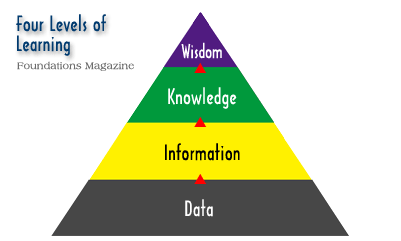 Heller asks, “How can we get people’s attention and begin to tell the truth? How can we learn to listen differently so that we know what the truth is?” A couple of key questions. Overcoming our own biases, preconceived ideas and faulty thinking make that all the more difficult. Heller offers some ideas. Two of the most important are, first, having the courage to say less. “This is the opportunity to evolve from being paid for how much you can do to being paid for how well you think.” Secondly, and frankly the most crucial, is making time to think. She suggests, “Pay quality attention to the things that matter, and give our brains some time to digest.” Make the time. More on developing wisdom:
Posted by Michael McKinney at 08:47 AM
02.25.07

Newswire: February 25, 2007
Posted by Michael McKinney at 10:27 AM
02.23.07

Hardiness: Keep On Breathing Without Letting Go
WINSTON CHURCHILL observed, “The nose of the bulldog has been slanted backwards so that he can breathe without letting go.” In today’s environment, leaders are pulled in all directions. It seems there are more responsibilities and pressures than ever before. Things can easily get out of hand and when they do it’s hard to keep on breathing without letting go. Of course, hardships and stress always accompany accomplishment. It’s important to remember that a strong commitment will carry you forward when nothing else will. Successful people have exceptionally high levels of tenacity and persistence and a general hardiness. Kouzes and Posner find hardiness an important ingredient for leadership success: First, people can’t lead if they aren’t psychologically hardy. No one will follow someone who avoids stressful events and won’t take decisive action. Second, even if their leaders are personally very hardy, they can’t enlist and retain others if they don’t create an atmosphere that promotes psychological hardiness. People won’t remain long with a cause that distresses them. They need to share their leader’s sense of commitment, control, and challenge.Increasing your hardiness has a lot to do with your context setting agility. As Bill Joiner and Stephen Josephs explain, Context setting agility includes scanning your environment, anticipating important changes, deciding what initiatives to take, scoping each initiative, and determining your desired outcomes. Your level of agility in carrying out these tasks depends on how fully you’ve developed two capacities: situational awareness and sense of purpose. Your agility level can also dip temporarily when you’re under high stress. At the same time, increasing your agility level can increase your capacity for dealing with stress.After Steve Jobs separation from Apple in 1985, he recalled, “You‘ve probably had someone punch you in the stomach. It knocks the wind out of you and you can’t breathe, If you relax, you can start breathing again.  That’s how I felt. The thing I had to do was to try to relax. It was hard. But I went for a lot of long walks in the woods and didn’t really talk to a lot of people.” (Steve Jobs: The Journey Is the Reward by Jeffrey Young) That’s how I felt. The thing I had to do was to try to relax. It was hard. But I went for a lot of long walks in the woods and didn’t really talk to a lot of people.” (Steve Jobs: The Journey Is the Reward by Jeffrey Young)
Hardiness. Winston Churchill certainly had it.
Posted by Michael McKinney at 06:35 AM
02.21.07

Keeping Your Ego in Check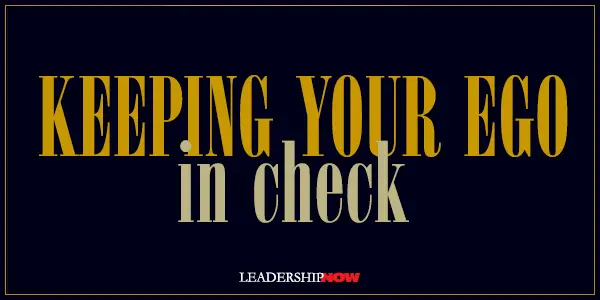
IF A LITTLE EGO is a good thing, too much can be a very bad thing. Managing one’s ego is the subject of Mathew Hayward’s book, Ego Check. “Checking one’s ego at the door is entirely the wrong way to think about managing overconfidence and hubris because it drives a wedge between who we are and how we are supposed to act. Instead, the key is to check our decisions and actions, ahead of time to determine whether they reflect authentic or false confidence.” He suggests that authentic pride is good—even necessary—as it helps us to “appreciate who we are and what we have done” without constantly seeking approval from others. He warns that “the danger is that authentic pride—based on real achievements and emotions—can quickly degenerate into excessive pride. We easily slip into becoming too full of ourselves and operate with clouded judgment. I believe it was Dirty Harry who said, “A man’s got to know his limitations.” He breaks excessive pride—which arises when we develop an inflated view of ourselves based on our need for certain outcomes and approval—into three forms: Dependent Pride: Pride based on what we hope to accomplish—future outcomes—rather than what we have done or are currently doing 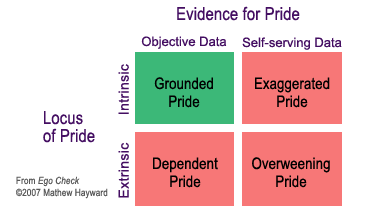 Authentic Pride or Grounded Pride arises when we intrinsically appreciate ourselves based on candid and factual feedback. This type of pride can be a positive force in our lives.   
Posted by Michael McKinney at 10:30 PM
02.19.07

Henry Kissinger on Vision: Seeing Through a Glass Darkly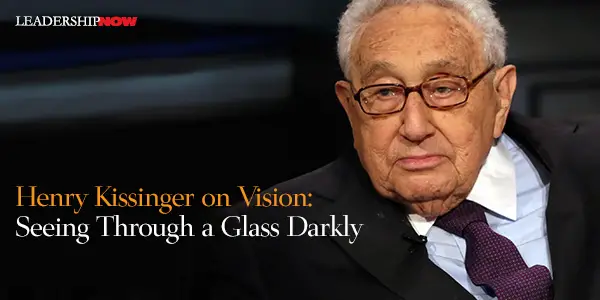
HENRY KISSINGER, then U.S. Secretary of State, explained in an interview with Los Angeles Times concerning the risky restoration of U.S. diplomatic relations with China, the dynamics of vision. “What a national leader has to do at such a time, is to take his society and the world, insofar as the issues are international, from where it is to where it has never been. This means he cannot prove the destination is desirable until the society or the world gets there.” Nixon himself once told professor Joan Hoff in an interview that the mark of a leader “is whether he can give history a nudge.” Nixon recognized that a leader should be inclusive. He wrote in a 1967 Foreign Affairs article, “Taking the long view, we simply cannot afford to leave China forever outside the family of nations, there to nurture its fantasies, cherish its hates and threaten its neighbors.”
Posted by Michael McKinney at 05:44 AM
02.16.07

In Difference Lies the Potential to Contribute WE tend to think that if we get the smartest people all together in one room, we will get the best solutions. In a very readable book, The Difference, Scott Page shows that in fact diversity in thinking and perspective produces more and better solutions and contributes to overall productivity. He maintains that “when confronted with a difficult task, be it solving a problem, predicting the future, or making a choice, we benefit by including diverse people.” Value can be added just by virtue of its being different. How many disciplines have benefited from interdisciplinary approaches? Diversity doesn’t necessarily mean black/white or men/women, but diversity in thinking and perspective. He notes that “cognitive diversity increases innovation. Preference diversity leads to squabbles.” So we’re looking for relevant diversity and informed intelligence. 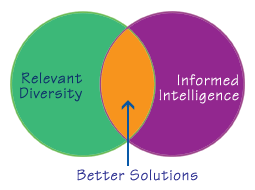 The trap we fall into is that we prefer to continue to work with and consult people who think like us—people with the same general background and types of experiences. The familiarity is more comfortable and seems right to us. In the end, we get the same way of looking at things and we bring the same kinds of tools to the table to tackle our problems. We miss important clues. If one of us gets stuck, then we all get stuck. “People who think alike get stuck.” We also create barriers to innovation and radically new ideas. A preference for working with people who bring the same formal perspectives to bear on a problem leads to segregation by function in firms and by discipline in the academy. In each case, the tendency to interact only with people like us creates the same micro-level dynamic. Each culture in a society, each identity group in a city, each department in a university, and each functional area of a firm ends up building walls around itself. As these walls become higher, the members of each group—be they Evangelicals, African Americans, chemists, or accountants—find themselves inside silos of their own creation. He suggests that we should not only get more kinds of people involved in tackling the issues, we should also encourage our people to think differently by giving them time to pursue individual projects that interest them (varied experience) and by creating skunk works type groups within the organization. He observes, “as individuals, we can accomplish only so much. We’re limited in our abilities. Our heads contain only so many neurons and axons. Collectively, we face no such constraint. We possess an incredible capacity to think differently. These differences can provide the seeds of innovation, progress, and understanding.” 
Posted by Michael McKinney at 08:56 AM
02.15.07

StrengthsFinder 2.0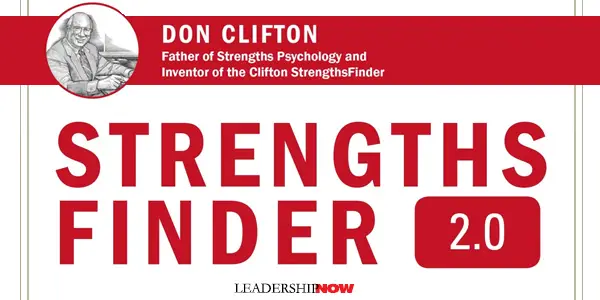
“Most people think they know what they are good at. They are usually wrong . . . . And yet, a person can perform only from strength.” GALLUP PRESS has just released StrengthsFinder 2.0. It’s a handy and improved follow-up to Now, Discover Your Strengths. What’s so new? Gallup has this to say: Our research and knowledge base on the topic of human strengths have expanded dramatically over the past decade. StrengthsFinder 2.0 picks up where the first version left off, and it is designed to provide you with the latest discoveries and strategies for application. The language of 34 themes remains the same, but the assessment is faster and even more reliable. And, the results yield a much more in-depth analysis of your strengths — featuring a look at the nuances of what makes you unique, using more than 5,000 personalized Strengths Insights that we have discovered in recent years. Going far beyond StrengthsFinder 1.0's shared theme descriptions, which can be found in Part II of StrengthsFinder 2.0, these highly customized Strengths Insights will help you understand how each of your top five themes plays out in your life on a much more personal level. For example, even though you and a friend may both have the same theme in your top five, the way this theme is manifested will not be the same. Therefore, each of you would receive entirely different, personalized descriptions of how that theme operates in your lives. These new Strengths Insights describe what makes you stand out when compared to the millions of people we have studied. Once you have completed the online assessment, you will receive a comprehensive Strengths Discovery and Action-Planning Guide that is based on your StrengthsFinder 2.0 results. This guide includes:

Posted by Michael McKinney at 09:51 AM
02.14.07

Simplicity: Focused and On Track Simple Solutions is directed toward getting things done. It’s about being able to “boil things down to their essence” and thereby bring complex issues down to a simple problem statement. To do this you must learn what is important to all stakeholders. Simplified problems are ones that can be acted one through effective, focused communication. Authors, Tom Schmitt and Arnold Perl provide some practical steps to build this skill. They define a continuum of leadership as: clarity of thought leads to simplicity, which leads to focus and powerful communication—the essence of leadership. Here are a few of the ideas found in this book:
Simple Solutions is directed toward getting things done. It’s about being able to “boil things down to their essence” and thereby bring complex issues down to a simple problem statement. To do this you must learn what is important to all stakeholders. Simplified problems are ones that can be acted one through effective, focused communication. Authors, Tom Schmitt and Arnold Perl provide some practical steps to build this skill. They define a continuum of leadership as: clarity of thought leads to simplicity, which leads to focus and powerful communication—the essence of leadership. Here are a few of the ideas found in this book:
Focus on the Amazing Goal, Not the Incremental. The deadly enemy of innovation is incrementalism. By just trying to make problems better a little bit at a time you can lose sight of the possibility of making a quantum leap. A useful question to help you look for amazing goals is, “What would have to be true in order to/for…?” The answer to the question helps you to think differently and make breakthroughs. Be Directionally Correct. “The fact is there will never be enough time or information to help you arrive at the perfect answer. The right answer can be one that is directionally correct. In other words, the solution may not be perfect, but it’s in the ballpark. This paves the way for more action but at least you’re already working with the customer and aren’t stuck back at the starting gate, still refining the model in the search for the non-existent perfect solution.” Determination versus Distractions. Determination is the willingness and ability to overcome obstacles and to avoid distractions. “Determination requires continued focus and commitment to a project. It requires the business savvy to separate the core of an issue from ancillary matters and then to continue plugging away at the core.” It is important to note though, “determination is an art. It requires walking a fine line between passionate focus and blind stubbornness. Use your judgment to determine if the goal needs to be simplified, changed, or even abandoned altogether. Don’t confuse sheer stubbornness with determination. 
Posted by Michael McKinney at 12:26 AM
02.12.07

When Making Judgments About Our Leaders and Others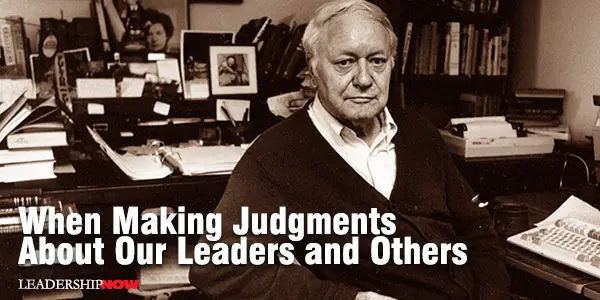
AS ONE OF the greatest journalists of all time, twice receiving the Pulitzer Prize, New York Times journalist James Reston (1909-1995) wrote in his memoirs about a trap we can fall into when judging others. He related how his wife, Sally, helped to temper his comments and writing. It’s a trap that we most easily fall into when we are overly focused on our own agenda or frustrated over simply not getting our own way. It’s good advice for any of us to keep in mind when we are getting ready to air our opinion—especially on social media. He wisely wrote: One of the blind spots of reporters is that after a while, we are inclined to forget that officials are people. Preoccupied with issues, we come to regard them as liberals or conservatives, honest or crooked, but seldom as ordinary folk who have wives and children and cry when they’re hurt. Sally was always saving me from this folly. She knew a lot of these official families and knew also when their kids were sick or flunking out of school or fiddling with drugs. Thus when some political luminary seemed to be in a slump, talking more nonsense than usual, she would say maybe he was worrying about the family, or, as I was inclined to believe, about his own wandering and wayward habits. Still, it was useful to be reminded that these headline characters have things to worry about other than the national debt—their own debts, for example. Times have changed. Journalism today is very different from the journalism Reston practiced. He said in on the occasion of the 50-year anniversary of the Pulitzer Prizes in 1966, that “Some of the old newspaper traditions, of course, we maintain. Our self-righteousness, I can assure you, is undiminished. Our capacity to criticize everybody and our imperviousness to criticism ourselves, are still, I believe, unmatched by novelists, poets or anybody else.” In Scotty: James B. Reston and the Rise and Fall of American Journalism, author John Stacks writes: He had access to the corridors of power because he was trusted to report and write with a sense of balance and humanity; He was often critical of policies and policy makers but rarely harsh on these judgments. He got to know the powerful as human beings, as people with strengths and weaknesses. He usually thought they were trying do their difficult jobs as well as they could and in what they saw as the best interests of the nation. There was, at the heart of Reston’s style of journalism, a sense of common purpose with the government and political leaders. He felt that journalism and government were integral parts of the fabric of the country, working in different ways toward the same goal: helping the country deal with threats to its health and survival from home and abroad. The press and government, although with different interests and different priorities, were seen by Reston as collaborators in on enterprise, the preservation of the United Sattes of America. 
Posted by Michael McKinney at 09:30 AM
02.11.07

Newswire: February 11, 2007

Posted by Michael McKinney at 05:50 PM
02.09.07

The Study of LeadershipIn a 1969 keynote address in Tokyo, Peter Drucker made the following observation about an aspect of leadership—management: There are management tools and techniques. There are management concepts and principles. There is a common language of management. And there may be even a universal "discipline" of management. Certainly there is a worldwide generic function which we call management and which serves the same purpose in any and all developed societies. But management is also a culture and a system of values and beliefs. It is also the means through which a given society makes productive its own values and beliefs. Indeed, management may well be considered the bridge between a “civilization” that is rapidly becoming worldwide, and a “culture” which expresses divergent traditions, values, beliefs, and heritages. Of course, along the same lines, leadership encompasses far more than the business or political environment we typically confine it to. From being the act of a few, it has become a personal responsibility. The issues we face today require a multidimensional understanding of leadership that is broader than most academic studies would give it. In fact the study of leadership is not the study of leadership at all, for leadership is the development of an individual’s whole being which is dynamic and ongoing.
Posted by Michael McKinney at 07:41 AM
02.08.07

Are We Hardwired For Success?Are we hardwired for success? Well yes, if we are working in sync with the way we are hardwired. It probably goes without saying that a person’s skill set helps to determine why they succeed or fail. Obviously, leveraging your particular skills will get you the most return on your effort and thus greater success.In Smarts, authors Chuck Martin, Peg Dawson and Richard Guare have identified 12 brain-based Executive Skills that are developed by young adulthood and are critical for decision making and regulation of behavior. They report that “Executive Skills are grounded in brain functions that have been demonstrated through research in the neurosciences to reside in specific brain locations and to become activated under predictable conditions.” The skills are:
The idea here, of course, is to understand your particular strengths and use that knowledge to match your skills to the type of work that requires or values your skill set. As Marcus Buckingham and others have pointed out, this is not easily or accurately done by introspection or guessing. The book does include the Executive Skills Profile to help you determine this. They explain, “People typically have two or three strengths and two or three weaknesses, with the remaining Executive Skills falling somewhere between. Those that are in between are not generally likely to get you into trouble, but those at the extremes can help you position yourself for greater successes and fewer failures.”
Posted by Michael McKinney at 11:10 AM
02.05.07

Take Another Look at Your Early Morning RoutineJim Citrin of executive search firm Spencer Stuart reported in his Yahoo! column that, "the quiet of the morning is often the time when your mind is at its clearest and most well-suited to solving important problems."
Steve Murphy, CEO of publishing company Rodale, says, "A line in a William Blake poem inspired me to think differently about my day: ‘Think in the morning, act in the noon, read in the evening, and sleep at night.' This has made a huge difference in my life. Now, I take out a yellow pad every morning and write my thoughts for the day, which allows me to be much more strategic and proactive than reactive." Citrin also confirms that a successful day usually starts early in the morning. (What was that Ben Franklin said?) He found that of the 20 executives he questioned, the latest any of them wake up is 6 am, and almost 80 percent wake up at 5:30 or earlier.
Posted by Michael McKinney at 07:26 AM
02.02.07

Not All Leaders Are the Same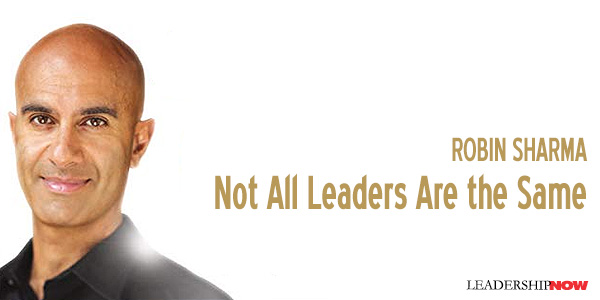
IN The Greatness Guide, Robin Sharma clarifies the mantra that leadership is everybody’s business. While everyone is a leader, not everyone does the same thing. Obviously, not everyone should be running the company. He explains: Know your role. Everyone needs to behave like a leader—no matter what they do. Everyone needs to demonstrate leadership traits—regardless of their position. That means everyone needs to take responsibility for getting results that they generate. Everyone needs to do their part to shape culture. Everyone needs to be positive and inspirational. Everyone needs to keep customers happy and protect the brand. Everyone is a leader. But not everyone is the same. 
Posted by Michael McKinney at 12:10 AM
02.01.07

Leadership Books: February 2007Here's a look at some of the best leadership books to be released in February.    
Posted by Michael McKinney at 01:29 AM
|
BUILD YOUR KNOWLEDGE


How to Do Your Start-Up Right STRAIGHT TALK FOR START-UPS 
Grow Your Leadership Skills NEW AND UPCOMING LEADERSHIP BOOKS 
Leadership Minute BITE-SIZE CONCEPTS YOU CAN CHEW ON 
Classic Leadership Books BOOKS TO READ BEFORE YOU LEAD |
|